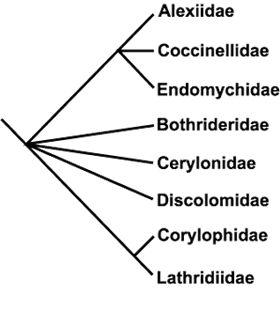
What is the Cerylonid Series?
Crowson (1955) was the first to recognize a cluster of highly derived families within Cucujoidea, which he named the Cerylonid Series. The group is characterized by the following features: Adults with tarsal formula reduced (4-4-4 or 3-3-3 in both sexes), wings lacking closed radial cell, anal veins reduced, aedeagus resting on side when retracted and tegmen reduced; Larvae with tarsungulus unisetose, spiracles usually annular, sensory appendage of 2nd antennal segment usually as long as 3rd segment.
Which families make up the Cerylonid Series?
The Cerylonid Series includes Bothrideridae, Cerylonidae, Coccinellidae, Corylophidae, Discolomatidae, Endomychidae, Latridiidae, and Alexiidae. Although only eight families comprise the Cerylonid Series, the group includes 40 subfamilies and more than half the genera (646 of 1,237) and species (9,600 of 19,090) of the entire superfamily Cucujoidea. It remains the only large superfamilial grouping of Cucujoidea assumed to form a clade (e.g., Slipinski 1990, Slipinski & Pakaluk 1992, Sen Gupta & Crowson 1973).